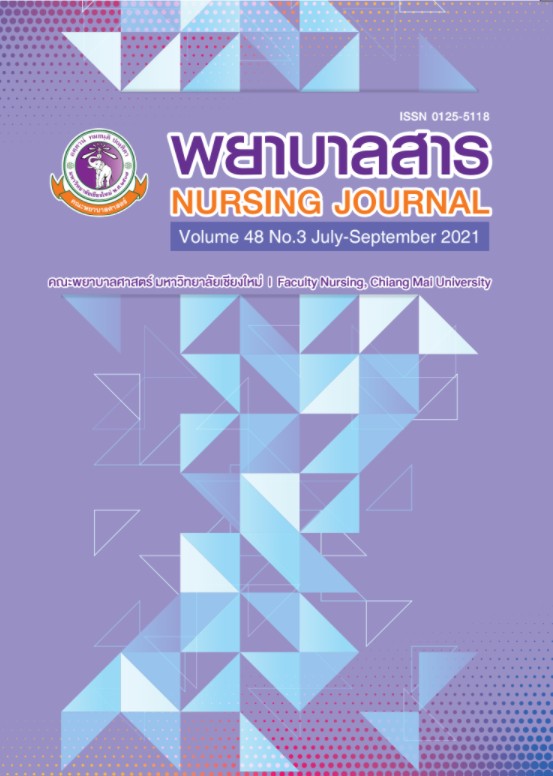Development of Video Media in Preventing Multidrug-Resistant Organisms Infections for Patients
Keywords:
Development, Video media, Prevention, Multidrug-resistant organisms, PatientsAbstract
Multidrug-resistant organisms (MDROs) infection is an international public health problem. Patients are at risk for MDROs infections due to many factors. Therefore, providing education on preventing MDROs infections for patients is crucial. This developmental research study aimed to develop video media for MDROs infection prevention for patients. The sample consisted of 42 patients undergoing treatment at a university hospital in Bangkok from November 2018 to May 2019. Research instruments included a development and design plan for the video media, a video media user opinion questionnaire, a demographic data questionnaire, a knowledge test on preventing MDROs infections, and a video media satisfaction questionnaire, all of which were validated by six content experts and three media experts. The content validity index of the knowledge test and the video media satisfaction questionnaire were .96 and 1.00 respectively, and the reliability were .72 and .91 respectively. The efficiency of the video media was tested using one-to-one, small group, and field test. Data were analyzed using descriptive statistics.
The video media developed for this study included two sections. Section one focused on MDROs infections in patients providing information on the definition of MDROs, factors related to MDROs infections in patients, the impact of MDROs infections in patients, and mode of transmissions of MDROs infections. Section two contained information on practices for preventing MDROs infections. The efficiency of the video media was 1.21, achieving Meguigans’s standard criteria of 1.00. User satisfaction of the video media was highest for content (4.30-4.83), design and presentation (4.57-4.77), and usability (4.87-4.90).
The results of the study show that the video media increased knowledge on MDROs infection prevention in patients, and should be disseminated to patients who are undergoing treatment in the hospital to increase knowledge, thus improving MDROs infection prevention practice.
References
Alessi, S. M., & Trollip, S. R. (1991). Computer based instruction: Methods and development (2nd ed.). New Jersey: Prentice Hall.
Baig, K., Din, S. M. S., Elkhizzi, N. A., & AlNakhli, D. J. (2015). Incidence of hospital acquired multidrug resistant organisms in a tertiary care facility. Journal of Infectious Diseases and Epidemiology, 1, 4.
Bastable, S. B. (2014). Nurse as education principles of teaching and learning for nursing practice (4th ed.). Massachusetts: Jones and Bartlett.
Centers for Disease Control and Prevention. (2017). Antibiotic/antimicrobial resistance. Retrieve from https://www.cdc.gov/drugresistance/index.html
Dhar, S., Marchaim, D., Tansek, R., Chopra, T., Yousuf, A., Bhargava, A., . . . Hingwe, A. (2014). Contact precautions more is not necessarily better. Infection Control and Hospital Epidemiology, 35(3), 213-221. doi:10.1086/675294
Gagne, R. (1985). The conditions of learning (4th Ed.). New York: Holt, Rinehart.
Ketphak, N., Picheansathian, W., & Klunklin, A. (2011). Effects of information provision using video media on patients’ knowledge and practices in prevention of nosocomial infection. Nursing Journal, 38(3), 98-109. (in Thai)
Knowles, M. S., Holton, E. F., & Swanson, R. A. (2005). Adult learner: The definitive classic in adult education and human resource development (6th ed.). Boston: Elsebier.
National Antimicrobial Resistance Surveillance Center Thailand. (2013). Antibiotic resistance in Thailand. (in Thai) Retrieved from http://narst.dmsc.moph.go.th/news001.html
Nuansakul, W. (2008). Video production process. Ubon Ratchathani: Office of academic resources Ubon Ratchathani University. (in Thai)
Ottum, A. (2013). Engaging patients in the prevention of health care-associated infections: A survey of patients’ awareness, knowledge, and perceptions regarding the risks and consequences of infection with methicillin-resistant Staphylococcus Aureus and Clostridium Difficile. American Journal of Infection Control, 41(4), 322-326.
Pholdee, N. (2018). Development of video media for preventing infections in cancer patients. Thesis Master of Nursing Science (Nursing Care for Patient with Infectious Disease and Infection Control), Graduate School, Chiang Mai University. (in Thai)
Tariyo, S. (2016). Knowledge, attitude and practice of hand hygiene among hospitalized patients. Thesis Master of Nursing Science (Nursing Care for Patient with Infectious Disease and Infection Control), Graduate School, Chiang Mai University. (in Thai)
Tiantong, M. (2005). Design and development of software for computer lessons. (2nded.). Bangkok: King Mongkut's Institute of Technology North Bangkok. (in Thai)
Utamachun, W. (2001). Television and computer media production. (2nded.). Bangkok: OS Printing House.
Viseskul, N. (2019). Development of media in nursing: Concepts and applications. Chiang Mai: Chotana Print. (in Thai)
World Health Organization. (2014). Antimicrobial resistance: Global report on surveillance. Retrieved from apps.who.int/iris/bitstream/10665/112642/1/9789241564748_eng.pdf
Downloads
Published
How to Cite
Issue
Section
License
บทความที่ได้รับการตีพิมพ์เป็นลิขสิทธิ์ของวารสารพยาบาลสาร
ข้อความที่ปรากฏในบทความแต่ละเรื่องในวารสารวิชาการเล่มนี้เป็นความคิดเห็นส่วนตัวของผู้เขียนแต่ละท่านไม่เกี่ยวข้องกับมหาวิทยาลัยเชียงใหม่ และคณาจารย์ท่านอื่นๆในมหาวิทยาลัยฯ แต่อย่างใด ความรับผิดชอบองค์ประกอบทั้งหมดของบทความแต่ละเรื่องเป็นของผู้เขียนแต่ละท่าน หากมีความผิดพลาดใด ๆ ผู้เขียนแต่ละท่านจะรับผิดชอบบทความของตนเองแต่ผู้เดียว






